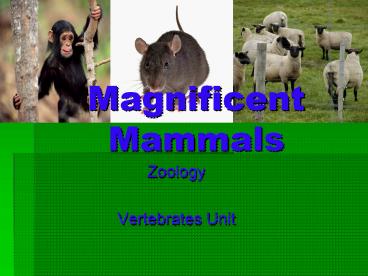Magnificent Mammals PowerPoint PPT Presentation
1 / 21
Title: Magnificent Mammals
1
Magnificent Mammals
- Zoology
- Vertebrates Unit
2
Classificationof Mammals
- Mammals are in the
- Kingdom Animalia
- Phylum Chordata
- Subphylum Vertebrata
- Class Mammalia
3
General Characteristics of Mammals
- Mammals have
- Hair (from a lot to a little)
- Specialized Teeth
- Endothermic bodies (warm-blooded, maintain
constant body temperature - Mammary Glands (used to feed and care for newborn
young) - Placenta (most have thesesupports and protects
the developing embryo) - Diaphragm (muscle that is used for breathing)
4
Specialized Teeth in Mammals
- Mammals have specialized teeth.
- Typically begin with a milk teeth set that
they lose to make room for permanent teeth
5
Types of Teeth
- The shape of mammal teeth depends on the function
of that tooth. - The three main types of teeth are
- Incisorsbiting
- Caninesstabbing and holding
- Molarscrushing and grinding
6
If the tooth fits
- Different mammals have different types of teeth
depending on their diet. - Predators have large canines.
- Herbivores have large, flat molars.
7
Three Main Types of Mammals
- Monotremes (lay eggs)
- Marsupials (have pouches used to care for young)
- Placentals (have a uterus and placenta)
8
Order Monotremata
- Egg-laying mammals only found in Australia
- Have reptilian characteristics like a cloaca and
egg laying - Have mammalian features like hair and mammary
glands
9
Order Marsupiala
- Young are born in an immature state and babies
develop in a pouch - Most are found in Australia but the opossum is
located on other continents - Examples kangaroo, wallaby, tasmanian devil,
koala, opossum
10
Placental Mammals
- Consist of animals in many different orders
- Have a gestation period where the developing baby
spends a specific time in the uterus - Have a placenta that is a special organ that
surrounds and protects the developing baby and
allows nutrients to pass from mom to baby - Some are domesticated and bred by humans, who are
also placental mammals.
11
Order Rodentia
- Placental mammal
- Teeth specialized for gnawing
- Examples mouse, rat, beaver
12
Order Chiroptera
- Placental mammal
- Fly with a membranous wing
- Use echolocation use sound waves to locate prey
and objects - Examples bats
13
Order Insectivora
- Placental mammal
- Have long noses
- Mainly eat insects
- Examples shrew, mole
14
Order Carnivora
- Placental mammal
- Large carnivores
- Hunt for food
- Examples dog, cat. Fox, bear, raccoon
15
Order Primate
- Adapted for living in trees
- Intelligent
- Opposable thumbs
- Examples chimpanzee, spider monkey, humans
16
Order Artiodactyla
- Placental mammal
- Ungulatehave hooves
- Even-toed
- Large rumen in stomach that helps break down
plant material - Examples sheep, cow,
17
Order Perissodactyla
- Placental mammal
- Ungulate (has hooves)
- Odd toed
- Examples horses, rhinoceros
18
Order Cetacea
- Placental mammal
- Marine mammals
- Use echolocation
- Have blowhole to release gases
- Examples whales, dolphins
19
Order Lagomorpha
- One pair of long incisors
- Legs specialized for hopping
- Examples rabbits and hares
20
Order Sirenia
- Placental mammal
- Marine mammals that live in shallow water
- Examples manatee, dugong
21
Order Proboscidea
- Proboscis (trunk)
- Many have long incisors (tusks)
- Examples elephants

